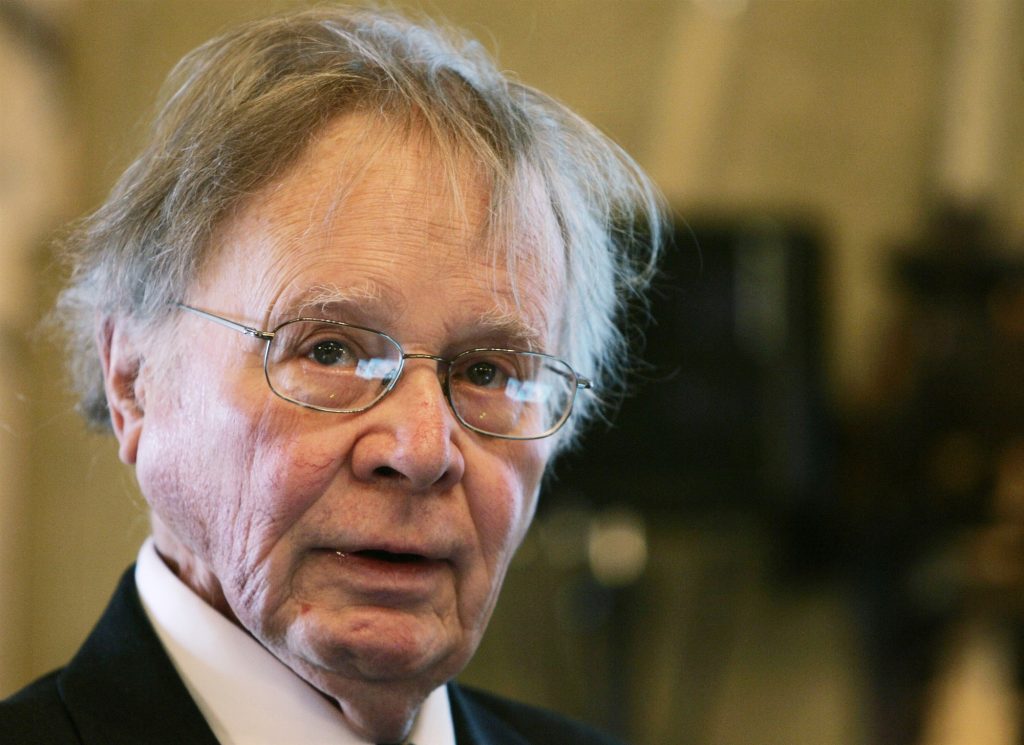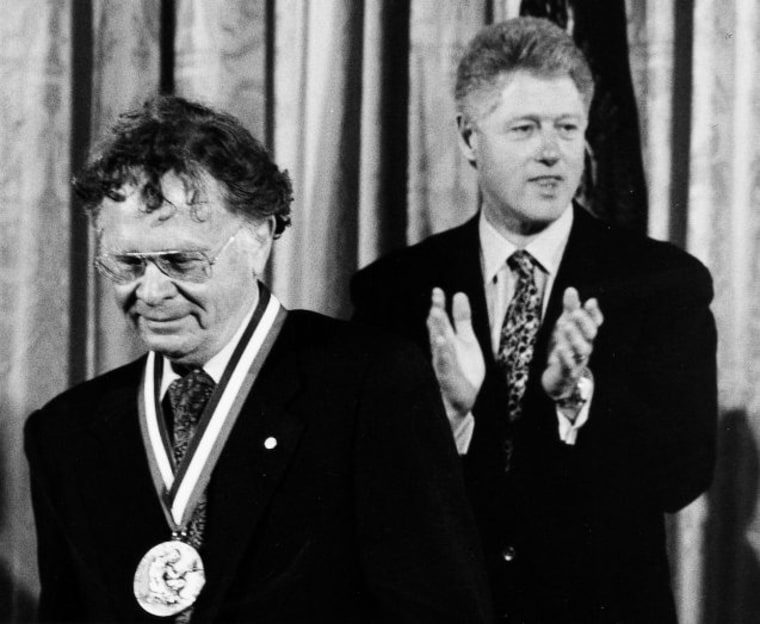Days before his death, Wallace Broecker urged scientists to consider deploying a last-ditch solar shield to stop global warming. As if they weren’t using geoengineering and spraying the skies already!

After struggling with heart disease for decades, the renowned climate scientist Wallace Smith Broecker had made it clear he was acutely aware of his own mortality. So when he sat down in front of a video camera to record a final message to his fellow scientists in mid-February, the 87-year-old researcher knew his days were few.
The man who popularized the term “global warming” and first described the critical role oceans play on climate had an urgent message for 40 of the world’s top climate scientists. Humanity is not moving quickly enough to slow the production of carbon dioxide that is warming the Earth, Broecker said Feb. 11, his livestreaming image projected onto a big screen at Arizona State University, where researchers had met to discuss untested solutions to global warming.
It was time for humankind and the world’s scientific community to begin to seriously study more extreme solutions to the climate crisis, Broecker said. That included creating a massive solar shield in the Earth’s atmosphere, a tactic known variously as “geoengineering,” “the sulfur solution,” “solar radiation management” and the “Pinatubo Strategy.”

“If we are going to prevent the planet from warming up another couple of degrees, we are going to have to go to geoengineering,” he said. The price of continued inaction, he added somewhat ominously, could be “many more surprises in the greenhouse” known as Earth.
Broecker regretted he could not be at Arizona State’s first Planetary Management Symposium on Climate Engineering but said he was glad he could address his longtime colleagues remotely. Though he was using a wheelchair and breathing through an oxygen tube, he assured his colleagues that “my mind is running pretty smoothly.”
A week after his dramatic appeal, Broecker died of congestive heart failure, inspiring praise for his work as the “grandfather” of modern climate science. His death, and his final message to scientists, re-energized the debate over the sort of re-engineering of the Earth’s climate systems that Broecker and other academics had broached as early as the 1970s.
Like cataclysmic Pinatubo eruption
The theory is that the planet might be cooled, in a worst-case scenario, by releasing massive amounts of sulfur dioxide into the atmosphere some 70,000 feet above the Earth’s surface. The idea would be for jets to release so much SO2 that they would mimic a massive volcanic eruption, like the one at Mt. Pinatubo in the Philippines in 1991, which shrouded much of the planet in a sulfurous cloud, cooling the Earth by about 1 degree Fahrenheit for a full year.
Many scientists have been hesitant about pursuing such an extreme measure, citing scientific, ethical, legal and political dilemmas. Tampering with Earth’s atmosphere was not a preferred alternative, Broecker had acknowledged, but he insisted that his fellow academics needed to be ready, should last-ditch measures be needed to prevent a climate catastrophe.
Broecker told the symposium that he had worked with another prominent climatologist on mechanical units that might remove carbon dioxide from the atmosphere. But 100 million of the devices would be needed to get the job done, he said, and there was no sign that the world’s leaders had the political will to get the job done.
More radical solution
In the days that followed, Broecker’s final admonition to his fellow climate scientists touched off an intensive discussion about whether humanity has reached a tipping point that requires more radical solutions. The debate has been conducted civilly and mostly via email among climate researchers around the world. It has no predictable outcome. A majority of the world’s climate scientists may oppose radical geoengineering, but most of those who heard Broecker’s words agreed that research on the sulfur solution should proceed.
Message hard to forget
Jeffrey Severinghaus, who studies ice cores to understand the history of global warming at the Scripps Institution of Oceanography at the University of California, San Diego, also described Broecker’s parting message as hard to forget.
“It was very touching. It was very profound,” Severinghaus, who studied under Broecke, said. “He was dying and every small effort was difficult for him. But it was important to him to speak to us.”
“This was the last message from someone who shaped our field for half a century,” said Peter Schlosser, the lead organizer of the symposium and vice president of Arizona State’s Global Futures program. “I don’t think his effort and his determination was lost on anyone.”
That sense of moment was acknowledged even by those, such as Severinghaus, who disagreed with Broecker’s position. Those scientists believe that sulfur injections into the atmosphere have too many potential pitfalls:
- They could alter weather and rainfall patterns so severely that agriculture would be disrupted on a mass scale. (Note: This is what is going on!)
- They could trigger unknown collateral weather calamities. (Note: This is what is going on!)
- They could prompt humanity to continue with the dangerous burning of fossil fuels. (Note: This is what is going on!)
“Even though I disagreed,” Severinghaus said, “I could see he was coming from a place of caring and concern for all of us and for the planet.”
SO2 Cooling
The Arizona State University meeting had been in the works for many months, prompted to a large degree by Broecker himself. The peripatetic scientist had written a memo in late 2017 to 17 colleagues, urging more intensive discussion about what he called “SO2 Cooling.”
“Over the last 50 years, the ratio of energy from fossil fuels (85 percent) to that from other sources (15 percent) has not changed. Several billion people still live in poverty. … Those who own fossil fuel reserves will do everything possible to make sure they are burned,” he wrote. “I wish I could be my usual optimistic self and believe those who say we are on the brink of an energy revolution. But I can’t.”
Following that 2017 memo, Broecker began to work with Schlosser and other old associates to organize a meeting about radical solutions to global warming.
The topic was provocative enough to draw some of the world’s leading climate scientists to the campus in Tempe, Arizona. While Broecker was too sick to join, his association with the event gave it extra appeal. Many recognized him as their mentor, a renaissance man who was not constrained by formal academic boundaries. “He had breadth of knowledge about Earth systems that few people could ever touch,” Schlosser said.
Broecker
Broecker grew up in the Chicago suburbs, the son of evangelical Christians. He attended a Christian liberal arts college and planned a career as an actuary, until a friend helped him land an internship at what would later become Columbia University’s Lamont-Doherty Earth Observatory. He immediately took to science and emerging fields like carbon dating and quickly transferred to Columbia. He spent the rest of his life studying the forces that affect the Earth’s climate.
Broecker often spoke about the climate system he studied for his entire academic life as “an angry beast,” adding, “and we are poking it with sticks.”
Like the vast majority of the scientific community, he supported a shift to sustainable fuels and away from oil, gas and coal. He also backed research into carbon capture technologies. But he despaired that humanity was moving too slowly and spoke in recent years with increasing fervor about the possible need for a solar shield.
“He was not advocating that it should be done, but he was advocating we should at least get the knowledge to enable us to decide whether or not we ought to look in that direction,” said Shepherd, an emeritus professor of Earth system science at the University of Southampton in England. “Wally could see his time on Earth was quite limited and I think he wanted to make sure there were a bunch of people who would carry on the initiative after he was gone.”
“Wally was never weak,” Clark said, “most especially when it came to science, most especially when it came to saving the planet to any and every degree possible.”
Geoengineering. It’s not the sexiest sounding topic, but a small group of scientists say it just might be able to save the world.











